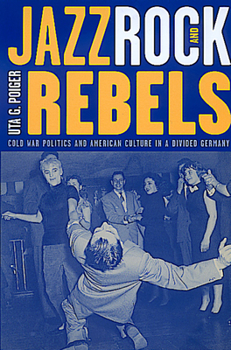Jazz, Rock, and Rebels: Cold War Politics and American Culture in a Divided Germany Volume 35
(Part of the Studies on the History of Society and Culture Series)
Select Format
Select Condition 
Book Overview
In the two decades after World War II, Germans on both sides of the iron curtain fought vehemently over American cultural imports. Uta G. Poiger traces how westerns, jeans, jazz, rock 'n' roll, and... This description may be from another edition of this product.
Format:Paperback
Language:English
ISBN:0520211391
ISBN13:9780520211391
Release Date:March 2000
Publisher:University of California Press
Length:346 Pages
Weight:1.25 lbs.
Dimensions:0.9" x 6.0" x 9.0"
Customer Reviews
3 ratings
Good book
Published by Thriftbooks.com User , 15 years ago
To say it with the words of the late comedienne, Gilda Radner ("Tiny Kingdom"): "This is a wonderful book!" It informs completely about all facets of jazz and rock in Cold War Germany and keeps many a surprise. It contains expressive photographs as well as funny caricatures and is well written. This is a book that swings and rocks.
Interesting Interpretation of Cold War Culture in East/West Blocs
Published by Thriftbooks.com User , 17 years ago
Breaking new historical ground, Uta Poiger explores the American cultural mediums that influenced Post-War East and West Germany in Jazz, Rock and Rebels: Cold War Politics and American Culture in a Divided Germany. Insightful and exhaustively researched, Poiger links the divided German states by a "discourse" bridge which seeks to manipulate American cultural influences to German prerogatives. The work is topically arraigned into five chapters, which collectively, link the popular culture of America in the 1950's to social injustices such as fascism and racism. Jazz music, for instance, was articulately utilized by the author to illustrate subtle differences and evolutions by the two Germanys. Initially, there was a social rejection of American Jazz music in the German states. According to Poiger, they "invoked antiblack . . . sentiments" as a method of reducing U.S. legitimacy. Over time, as Poiger noted, this stigma for jazz evaporated and became more of an accepted norm in German culture. And reviewer, Katrin Sieg, Georgetown Professor of German Studies, lauded Poiger for her tight knit handling of racial digression, and added that "as the Nazi past was discredited, biological models of racial hierarchy, or indeed the very concept of race, disappeared from public language, to be displaced by psychology as the main paradigm explaining and articulating human differences." The reader will discover many anecdotes, such as the aforementioned one, that provide convincing evidence that American culture was either embraced, or thwarted, by the two states depending on each side's definition of national identity. However, Poiger falls short of weaving a compelling argument that German adolescents were politically influenced by American culture. Although it was clear that both Germanys were inundated with U.S. movies, fashion, and Elvis style Rock n' Roll, no obvious parallels were installed to illustrate how these youth translated American culture into German political alignments. One Social Historian, Donna Harsch, echoed this assessment of Poiger's treatment of German youth and added that, "cultural habits of 1950s youth were, by and large, apolitical." Rebellious German youth may have enjoyed the age of promiscuous temptations by sampling various cultural pleasures enjoyed by Americans, but how these ventures equated to Germaness, or political identity, remains nebulous for the reader. Logically argued, this work contributed, more than it contracted, from the cultural and Cold War history of Post-War Germany. I appreciated the healthy samplings of German artist renderings and propaganda posters, which added a rich dimension to the overall excellent scholarship of this work. Best suited for German, Cold War, gender, cultural and racial scholars, but appropriate for graduate and undergraduate students who have an eye for cultural or gender history, this work would be and interesting read to both the scholar and leisurely reader.
Rethinking Cultural Imperialism
Published by Thriftbooks.com User , 23 years ago
This book is an innovative study of the impact of American culture on both East and West Germany in the 1950s and early 60s. It is highly readable and always interesting, tracing the cultural and political impact of jazz, rock-n-roll, and American "rebel" movies like the Wild One or Rebel Without a Cause. The book looks at the reactions of state officials and experts, who vacillated between decrying the American imports as imperial "un-culture" and trying to appropriate them as resources for the cold war conflict between East and West. Perhaps more importantly, it also examines the reactions of the young fans, who used these American cultural products to stage their own rebellions against state authority and official norms. Always attentive to issues of race and gender, subtle and yet clear, this is a great analysis that goes well beyond the usual terms of the debate about cultural imperialism.





